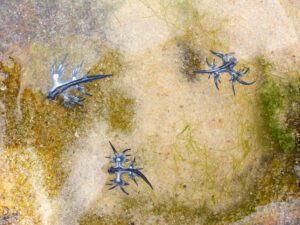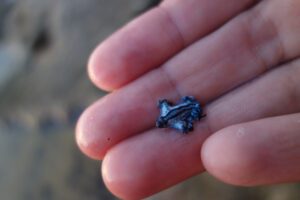If you think you are the kind who’d be compelled to pick a Blue Dragon up for a closer look, you may want to think twice.

Blue Dragons were spotted on Elliot's Beach in Besant Nagar. (iStock)
If you are a Chennai resident, you’d have most likely heard of Blue Dragons in the recent week. These ornate creatures were spotted recently on Elliot’s Beach in Besant Nagar.
Following the phenomenon, there have been reports doing the rounds asking beachgoers to stay alert. But is there anything to panic about?
For the uninitiated, the Blue Dragon (Glaucus atlanticus) is a type of mollusk, or sea slug, often found on the surface of the Atlantic, Pacific, and Indian oceans in temperate and tropical waters around the world.
Although they live in the open ocean, they sometimes wash up on to the shore, making for appearances against the beige sand.
If you think you are the kind who’d be compelled to pick the stunning creatures up for a closer look, you may want to think twice. While they are non-lethal, they could sting you, experts say.

Sighting Blue Dragons on the beach is not uncommon for the fishing community. (iStock)
While the Blue Dragons were having their paparazzi moment with the common person, for the fishing community in Urur Kuppam, this sighting is not new. They report that these creatures make regular appearances, especially after a strong weather event.
“This phenomenon is not uncommon. This creature is particularly active during specific oceanic conditions, especially when there are high currents,” says Palayam, a fisherman from Urur Kuppam.
Palayam emphasises that Blue Dragon’s presence correlates with the depression in the sea, and alterations in wind and rain influence its movement. This phenomenon alters the colour and roughness of the water, setting it apart from normal sea conditions.
“For the past few days, the winds have been from the northeast. And the current has been from east to west. The eastern current is called Olini in Tamil. Because of Olini, there is a constant push of everything that is deep in the ocean. Since these creatures are floaters, they ride the current and land on the beach,” he explains.
In terms of potential danger, Palayam advises against touching them with bare hands, as it can induce reactions akin to venomous bites. A recent incident during data collection in Kattupalli saw an individual experiencing symptoms after direct contact with Blue Dragon, he shares.
“It causes intense localised pain, sometimes leading to fever. Although not life-threatening, one should seek medical attention if needed,” he informs South First.
If it stings and you need to remove it from your feet, don’t use bare hands but instead opt for a stick, he adds.
According to naturalist Yuvan Aves, there is nothing alarming about coming across the Blue Dragons. They are just fascinating creatures, says the environment activist, who has written extensively about them in his recent book Intertidal.

The sting of a Blue Dragon is not lethal, however one should seek medical attention if necessary. (iStock)
“In the ocean, there are Gyres which is where the ocean currents meet. The water does not move around much there. These are the places where Blue Buttons (Porpita Porpita) live. There is a range of creatures that feed off them and live where they do. One of them is the Blue Dragon,” shares Aves.
However, it’s true that they could sting.
The Blue Dragon feeds on venomous siphonophores including the by-the-wind-sailor (Velella velella); the blue button (Porpita porpita); the violet snail, and the dangerously venomous Portuguese man o’ war.
“There are certain species of caterpillars that eat poisonous plants and do not digest the poison. Instead, they store it in their tissue to become poisonous themselves. Similarly, Blue Dragons sequester the nematocysts (stinging cells) of the blue button and become stinging creatures. Only the adult Blue Dragons will sequester enough cells to sting,” elaborates Aves.
However, if you come in contact with the Blue Dragon, it will cause an itch or an allergic reaction, but it’s not life threatening, he adds.
But one must be cautious of Man o’ wars.
“Man o’ wars are rare on Chennai beaches. But I have seen them a few times. They are considered lethal. It’s possible that among the millions of Blue Dragons that beach, there will be a few Man o’ wars,” he points out.
It can’t be ruled out that the recent sighting occurred in the aftermath of Cyclone Michaung.
“Changes in sea conditions were observed after the recent cyclone, with continuous north winds bringing waves to the shore,” Palayam notes. “During such circumstances, Nete (Blue Dragon) tends to approach the shore. It is not necessarily dangerous,” he adds.
Yuvan agrees.
“There is a huge community of creatures that live around the Blue Buttons. None of them are capable of swimming long distances. They come to the shore only when something pushes them to the beach. During strong weather events or seismic events, these creatures beach. Sometimes it’s because of the events within the ocean that we don’t know about. But 90 percent of the time, it happens before or after a cyclone.”
“Right now there is a storm hitting the Tirunelveli-Tiruchendur area. Or it could be the aftermath of the cyclone that hit Chennai. Since the Blue Dragons have been spotted from December 10 onwards, I feel it can be attributed to the cyclone,” he adds.
So, should you ever come in contact with the Blue Dragons, be appropriately awed, but it would be wise not to pet them.

May 06, 2024

May 06, 2024

May 06, 2024

May 06, 2024

May 06, 2024

May 06, 2024